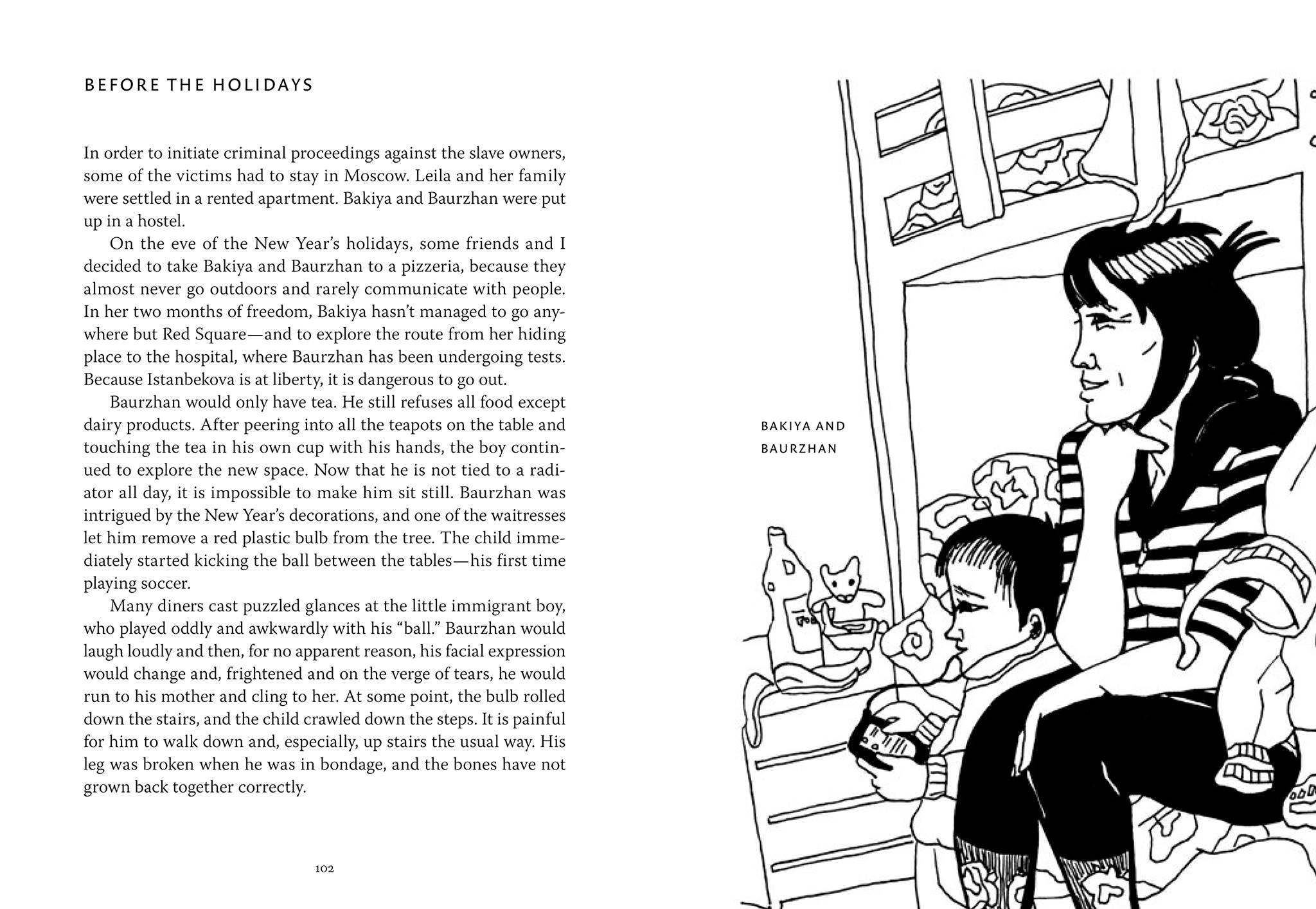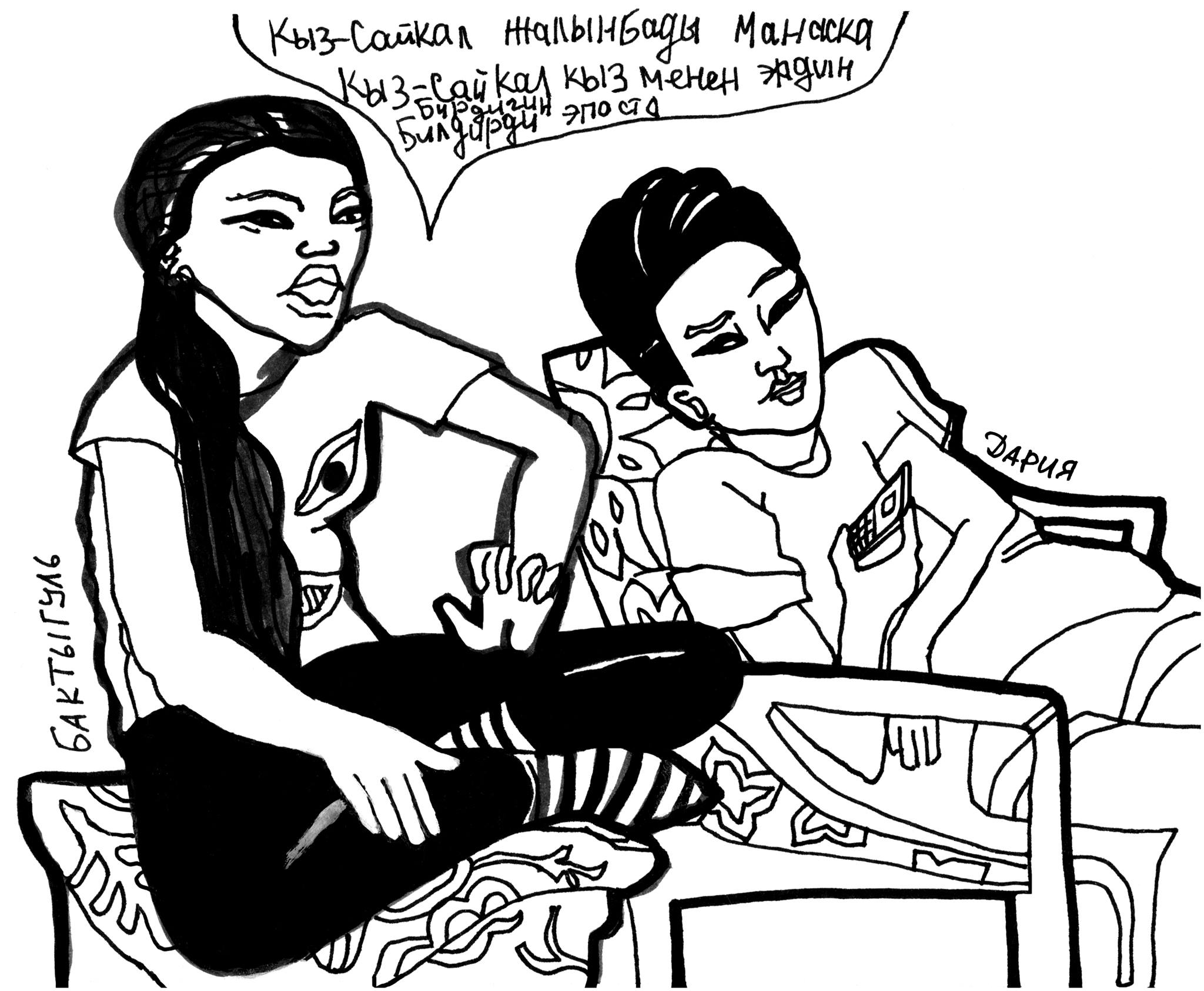Victoria Lomasko is a fixture at Moscow’s trials and protests, documenting the tumultuous processes that shape today’s Russia. Not content to limit herself to the political life of the country’s capital, Lomasko travels around the country and through the former Soviet republics, exploring the domestic, psychological, and spiritual condition of its diverse marginalized groups. Sex workers in Nizhny Novgorod, women in underground lesbian clubs, teachers in a remote village school, and children at the juvenile prison colonies, where Lomasko volunteers as an art teacher, have been some of the subjects of her sensitive, incisive portraits. With empathy at the heart of her approach, Lomasko is drawn to people who challenge her, whose stories do not necessarily illustrate her own political views. In her graphic reportages, we find a panorama of modern Russian society. Her new book, Other Russias, translated from Russian by Tom Campbell, recently came out of n+1’s publishing house. The following interview, conducted by Nigâr Hacızade and Rossen Djagalov, is published in cooperation with Openleft.ru, All the Russias’ Blog of NYU’s Jordan Center, and 5harfliler.com.
Rossen Djagalov: I would like to start off with a question about populism in art. It seems to me, that the art that is called “left” in today’s Eastern Europe is predominantly elitist in nature. In other words, politically engaged art today tends towards the conceptual, performance-based styles applauded by Western critics. As a result, they are relatively successful abroad, while they appear to be doomed to a rather narrow audience, with a questionable political impact in their home countries. In my opinion, your graphic reportage, like the music of Kirill Medvedev, is the result of a conscious search for a form that can bring a certain political message not only to elite Moscow circles, but to a wider class base, one that is not necessarily versed in modern art. Perhaps, this is all just my imagination. I understand, that every artist wishes for as many people to see his or her works, but what are your thoughts about the public you seek?
Victoria Lomasko: I believe that every genre and every media has its own strong and weak points. For example, in Russia, of course, the majority of people hold very traditional views of culture and my graphic reportage, with its rather realistic drawings and texts, are easy to understand. For such a traditional viewer, it’s also important that the art is done “artfully”; in other words, that the skill necessary for creation is evident. The viewer needs to be able to say that “I would not able to create this, this was created by a real artist, and therefore, it is more valuable.” On the other hand, people are increasingly becoming aware of radical performance art, not only in Moscow, but even in the deep provinces, people know about Pussy Riot, have heard something of the group Voina (War) and something of Pavlensky. They have heard about it, but still understand it as hooliganism. Of course, another negative factor with performance art is that its artists very quickly reach their own limits. For example, what further actions could have Pussy Riot undertaken had the police not imprisoned them? What to do after dancing in the Church of Christ the Savior? The next actions would inevitably have worn either a half-criminal or self-destructive character. For example, the last performance of Voina, “The Palace Coup,” already bordered on the destruction of governmental property. So these statements are incredibly media-centric, but after making them, the artist must leave and find some new outlet or field. My graphic reportages speak in a softer voice. No one will be so struck by with them that they will rush to their neighbors to share them: “Did you know, I read such a reportage about truck drivers!” But at the same time, they are like tiny bricks; each work builds upon the previous one, and if I have readers, they grow with me. With each story, we understand something greater, together. But my works are not as widely known as the information about their actions.
I think that we need both types of art: there should be an abundance of everything. It’s especially useless to argue about which type is more important or works better in contemporary Russia, which is an art desert. One doesn’t wish to criticize anything that appears, but should rejoice by the sheer fact it has appeared.
Nigâr Hacızade: I have a question. When I hear the words “reportage” and “documentary drawings,” I, of course, immediately think about journalism. In what way, do you think, does the work you do parallel, fill a hole in, or maybe, even replace journalism? Because you call yourself an artist.
Victoria Lomasko: I actually have this feeling that what we need right now in Russia are some hybrid forms of journalism that can address the problems with actually existing journalism. In Russia as a whole, and in Moscow in particular, there’s always a myriad of everyday bad news, truly bad, strange news, say, terrorist attacks, accidents in the metro, new legislative horrors. Because of the way our journalism operates, these incidents are forgotten within a day, as though nothing has ever happened. Take, for example, the case when I produced the reportage about the freed female slaves from a typical grocery store. On the first day, which is when many news outlets talked about this case and even sent reporters, this was a shock to most readers. “How? In Moscow? There are women slaves in many stores, who for ten years have been beaten and violated, and even although the police is aware of this, they were only freed by some activists?” But by the next day, another portion of news items arrives, a new horrible law has been passed or something of the sort. And we just feel horrified, but do nothing. How can we help, push readers, to not only be astonished or horrified for a day, but also, to join in and act? What is necessary for this, perhaps, is not to abandon the story and its characters and move on, but to keep track of them over a period of time after the regular journalists are gone.
And so, when these women were freed from slavery, I met with them quite frequently, every time asking them to tell me what they have been doing, what their further plans are, what they need. And after each meeting, I posted one drawing and wrote one paragraph on social media. For example, it will soon be New Year’s and the freed women and their children need a Christmas tree and presents. Or Leila has only summer flats and it’s already snowing. And because this information consistently appeared on Facebook and Life-Journal, people already had the feeling that they have a relationship with these people, that they see them, they are interested in what will happen to them. And indeed, someone donated a fur coat, others gave toys for the kids and a toy fir tree for New Years.
Or take, for example, the situation of the Russian truck drivers protesting unfair fees or the defenders of Torfyanka Park, who also camped out to protest the building of a church on the territory of their park. This kind of solidarity is very unusual for Russia: how people with different political opinions, often very distant from the world of high politics unite to achieve something. And both these protests continue. The initiatives have not fallen apart. Imagine, for example, the truck drivers, who came and lived in wagons from December to May! This means they had to wash up in IKEA, eat ramen noodles all the time; this is really a very hard life. In addition, it was winter, freezing weather, and yet they continued to sleep in coats, to type leaflets in one of the wagons, to distribute them in different truck stations, to organize meetings for drivers in different regions and even organize a whole strike.
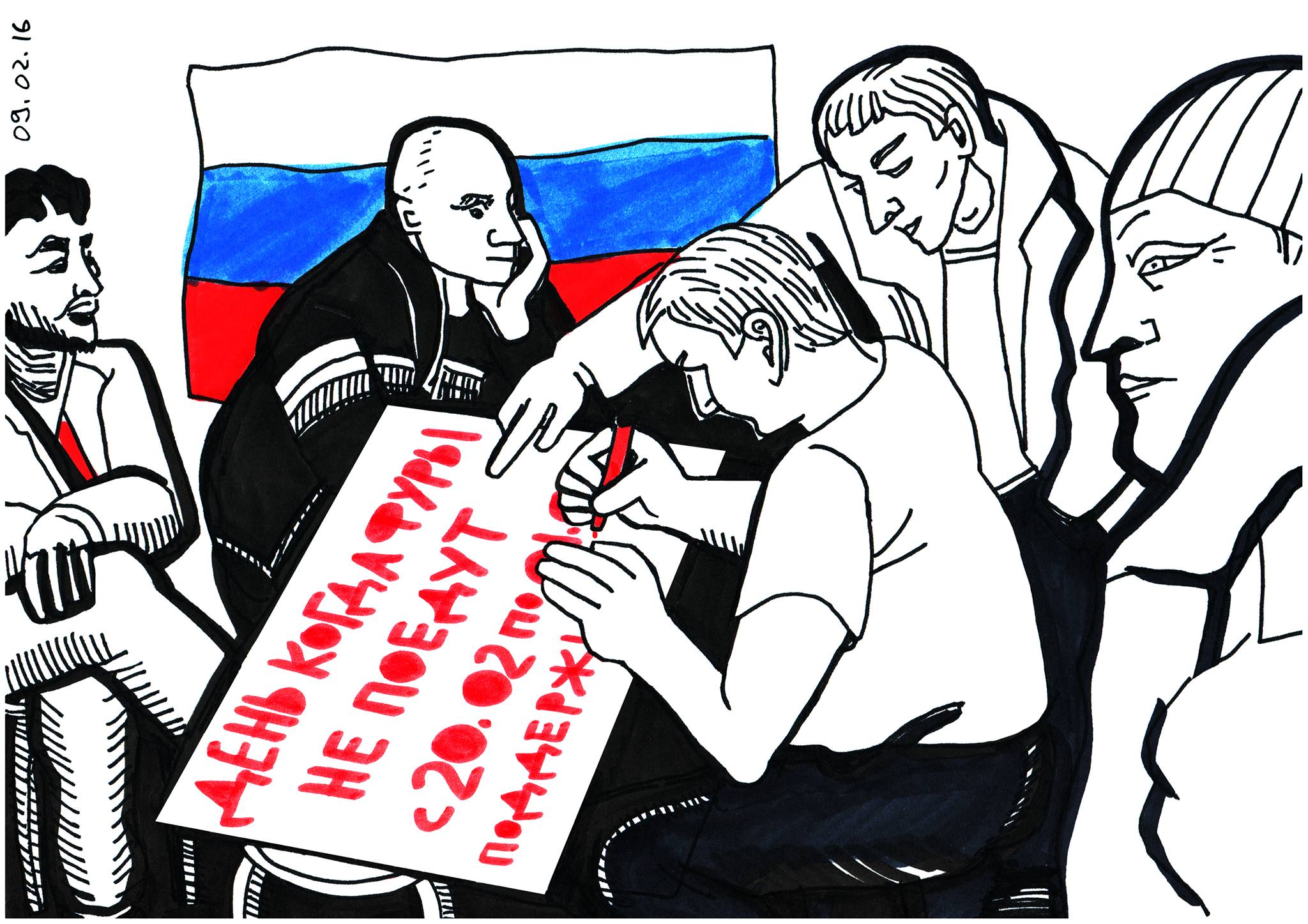
Who, really, who, from the intelligentsia is even capable of something like that? I am just shocked by the everyday heroism of these people! But our journalists only came when something bright and flashy happened. For example, if a strike is called, they are there on the first day, but never show up afterwards. But this sort of initiative requires long-term commitment and sacrifice.
Rossen Djagalov: Are there examples from Russian or foreign art traditions that inspire you?
Victoria Lomasko: I am extremely interested, always, in what fits in with what, what preceded what, and how and why traditions change. As someone who tries to depict life outside of the capital and who has travelled to Dagestan and Kyrgystan, I am fascinated by the figure of the nineteenth-century Russian painter Vasily Vereshchagin. Of course, because of his participation in colonial wars, because of his politics, I find it impossible to identify with him, but his great attention to social detail deserves admiration. I am similarly interested in historical albums: military, revolutionary, of the Leningrad blockade, of concentration camps.
Rossen Djagalov: In the United States, at least, there exists a subgenre of political comics, of which the most well-known representative is Joe Sacco. How do you relate to it?
Victoria Lomasko: This genre is particularly strong in France. I published in Liberación and Charlie Hebdo, but to continue collaboration with these publications, I was told that “how about you keep doing what you’re doing, but just in such a way that our readers can consume everything in the format they are used to.” Drawing in regular frames, as in the Western graphic novel, would have been very difficult for me precisely because I draw everything on the spot. Improvisation—something I try to preserve in my drawings–would be impossible if you then have to draw frame by the frame and plan everything out in advance. I would have lost the feeling when the drawing is done right here and now.I have an archive, which I collected, of Revolutionary Russian graphics from 1905 to 1917. It contains, for example, the drawing of an artist who accidentally saw the first shot of the Aurora, just as he was passing by. And it’s drawn so quickly, that you can’t even really understand what’s happening, but the rhythm of the line…you understand, that whatever it was, it was deeply important.
Nigâr Hacızade: It’s like a live broadcast.
Victoria Lomasko: Yes. Another artist I am interested in is Ivan Vladimirov, who was a real professional war correspondent, drew during several wars, and then drew the Revolution of 1905 and then of 1917. He even signed up for the People’s Police in order to keep his hand right on the pulse of events. Or speaking of 1905, perhaps the most powerful work of that year is Valentin’s Serov’s work about Bloody Sunday, called Soldiers, Our little heroes, where Is Your Glory? He had seen the shooting of the unarmed crowd out of the Academy window and, I think, could represent the tragedy both as a concrete event and as a symbol about any state massacring its own people.
Rossen Djagalov: I’m very interested in how other artists perceive your work, your obvious political message? Have you noticed a change in their attitude over time?
Victoria Lomasko: That’s another interesting question: how is an artist’s reputation made today? I have noticed that in Russia, this process occurs differently than in other European countries. This is probably because Europe has what I would call a “healthy” artistic competition. Whereas in Russia, basic evaluative mechanisms don’t exist: first, one needs to become famous abroad and then, perhaps, our Russian art critics will repeat something after their Western colleagues. Journalists, by contrast, are more important: many artists’ names were actually made by journalists. This is at least the case with me: during the protests of 2012, many of my pieces were published. The fame of Pussy Riot was also made by journalists, while our art critics were arguing with each other over a cup of cognac whether their punk prayer constitutes hooliganism or art. The same is true in the case of Pavlensky or of Artem Loskutov, the organizer of Monstration (a yearly demo with absurd slogans). There are many more interesting things that our art critics completely ignore, like Darya Serenko’s silent protest called “Quiet Picket,” which consists of her preparing a new, very visually simple, poster each time she rides the Moscow metro. Maybe it’s about the war in Ukraine, about the persecution of LGBT people, about domestic violence, about the passing of a new law or about political courts. And she rides with these posters in our metro, where everyone tries to keep low and not stand out. So imagine, in our metro, where everything is black, grey and brown, there are almost no signs, no slogans, and suddenly, there is this girl carrying a big poster, on which there is a question about the war in Ukraine, or repressions against the LGBT community, family violence, political trials, new laws. And people enter into a dialogue, a discussion develops in the whole car. But the only people who write about her are journalists.
Rossen Djagalov: It’s fascinating that 2012 and its protests made it a landmark year for your graphic reportage. In other words, your work is somehow connected with the rise of social movements?
Victoria Lomasko: In today’s Russia, whatever phenomenon you try to examine, it’s impossible to escape major social problems. But when you try to document these issues, you inevitably encounter censorship. For example, one of my friends lives in a village four hours away from Moscow, where she is the director of a small museum. She began to reproach me that I draw only gloomy works; could I really not say anything positive? I said, “Why don’t you suggest a topic?” “Come to our village, my parents teach in the village school, everything is great there and you can write something about it.” I come–it’s spring, there’s flooding so one must go to school by boat and there are only two or three students because the whole village is dying. There’s no work, parents are alcoholics, kids already have psychological disorders and the school is about to close.
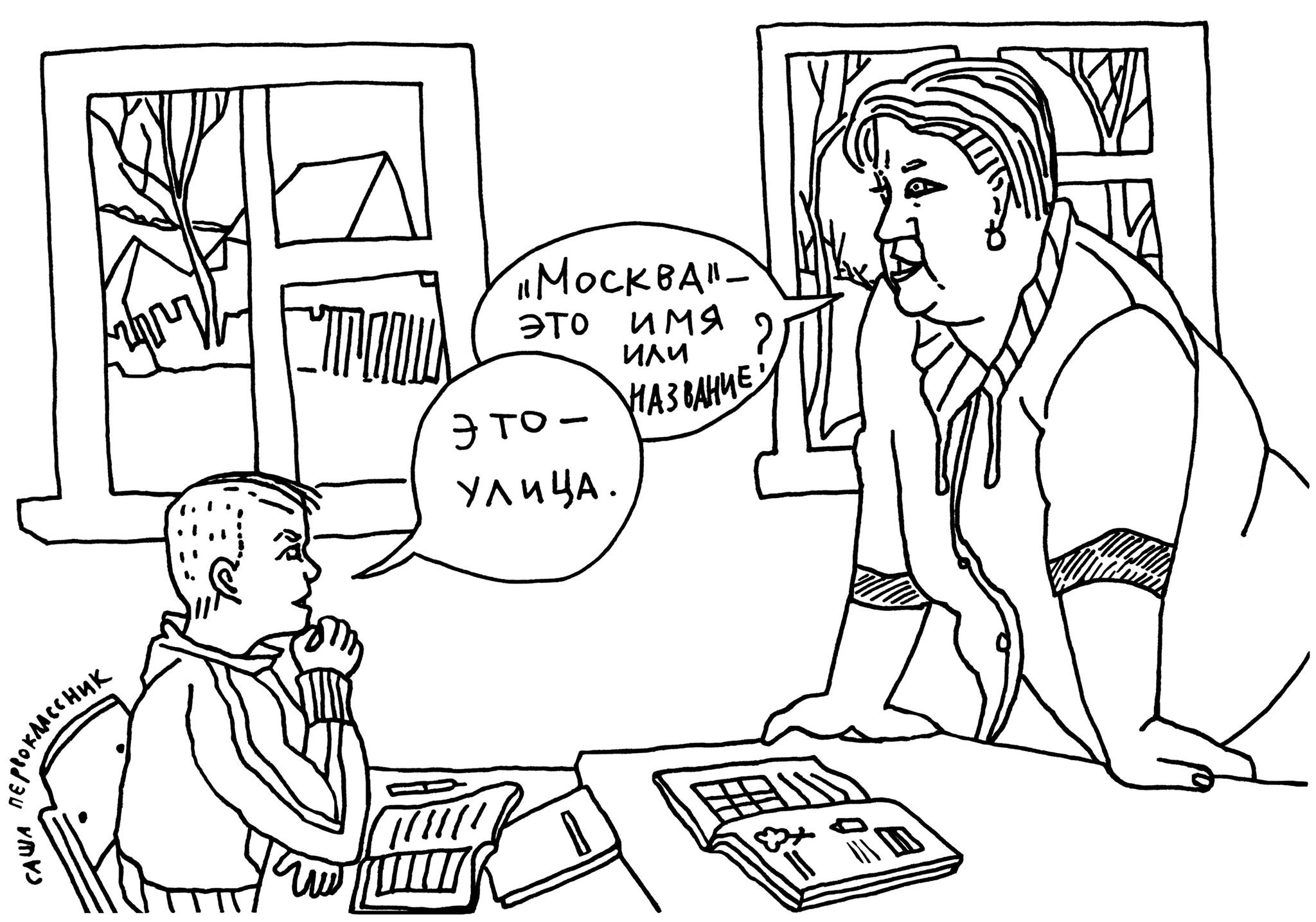
I immediately draw and write all this up, and when I show it to my friend and her parents, they say “and what’s interesting about this? This is normal life, is it ever otherwise? You made such a boring story.” Later, I publish it and when the Moscow people read it, they say, “Can this be here, in Russia?” They never go beyond the Sadovoe Ring (a ring road that separates Moscow’s center from the rest of the city) unless they are going to Europe.
Nigâr Hacızade: Do you show your drawings, your work, to those whom you draw? If so, what is their reaction?
Victoria Lomasko: In most cases, it’s positive. People generally like suddenly finding themselves as characters of a drawing. Many ask to take a picture of it, or to have a scanned version. Aggressive reactions are very rare. I almost don’t even remember any such cases.
Nigâr Hacızade: That points to a very interesting contrast with journalism, where so many people refuse to be photographed.
Victoria Lomasko: Yes, and in Russia there are more and more subjects who would be endangered by photo or video publications. This is why the first section of my book Other Russias is called The Invisibles. They really are invisible and they won’t show their faces, because it’s dangerous. One reportage that was particularly difficult for me to do concerned HIV positive people who can’t even reveal their status to their own families. If they do, they can lose everything: their family, their jobs, and the opportunity to be treated. This reportage was commissioned by OXFAM. They had initially wanted photos and video footage, but every single person refused; not one of them, however, refused to be drawn. The same holds true with sex workers and immigrants. And I see that people want to be drawn. They want for their demands, voices, resentments, to be in the public space, but just not at the cost of making their immediate situation even worse.
Nigâr Hacızade: How do you see the subject of the rights of women, especially in Armenia, Georgia, Central Asia, places that you have visited and you have drawn? How have they changed since the fall of the Soviet Union?
Victoria Lomasko: I see that society is becoming increasingly conservative and, of course, this strongly affects the treatment of women. For instance, in Kyrgyzstan, if a girl is from a well-off, liberal family—I’m speaking of someone from Bishkek or, at least, Osh—then she may know other languages or be sent to study abroad. But at the same time, many of her peers from more conservative families are already walking around in hijabs, in long clothing, and are getting married off earlier.
Nigâr Hacızade: And the disparity is probably increasing?
Victoria Lomasko: Yes, it’s increasing. For all its incredible problems, the Soviet state at least made a point of fighting polygamy, of penalizing marriages to thirteen-year-old girls, kidnappings and severe domestic abuse; but now, there is nobody to fulfill this role and, perhaps, society has become even more conservative and is all too often ready to stand on the side of the oppressor.
Nigâr Hacızade: Is this a reaction to the Soviet regime, and the way it forced everyone to be socialist and abandon religion?
Victoria Lomasko: In many Soviet republics or regions, such as the North Caucasus, Uzbekistan or Tajikistan, the Soviet state put immense pressure on men to allow women to study and work. In late socialism, it looked as if honor killings were becoming legends of the past. Nowadays, wives, daughters, and nieces are being killed in Chechnya or Dagestan all the time. As long as the murder was done by a man in the family, there will be no investigation.
Nigâr Hacızade: How about Georgia and Armenia? Is the same thing happening in the whole region, or is this, after all, more prevalent in Muslim countries?
Victoria Lomasko: There is much more pressure in Muslim societies, but, for example, in Armenia or Georgia, even my peers, women over 30, speak of how their parents, relatives and even neighbors try to control their sexuality. They try to make sure that they are married, or at least want them to pretend that they are married for the benefit of the neighbors, because it’s a big issue to have sexual contact outside of marriage. Once I was spending time with very hip people in the most “modern” place in Tbilisi. This cafe is considered to be “the place”: everyone’s temples were shaved, and everyone had tattoos and piercings. And my Georgian friends offered to share a secret: the majority of the people you see here, they are virgins, and if they do have a partner, no one knows about it.
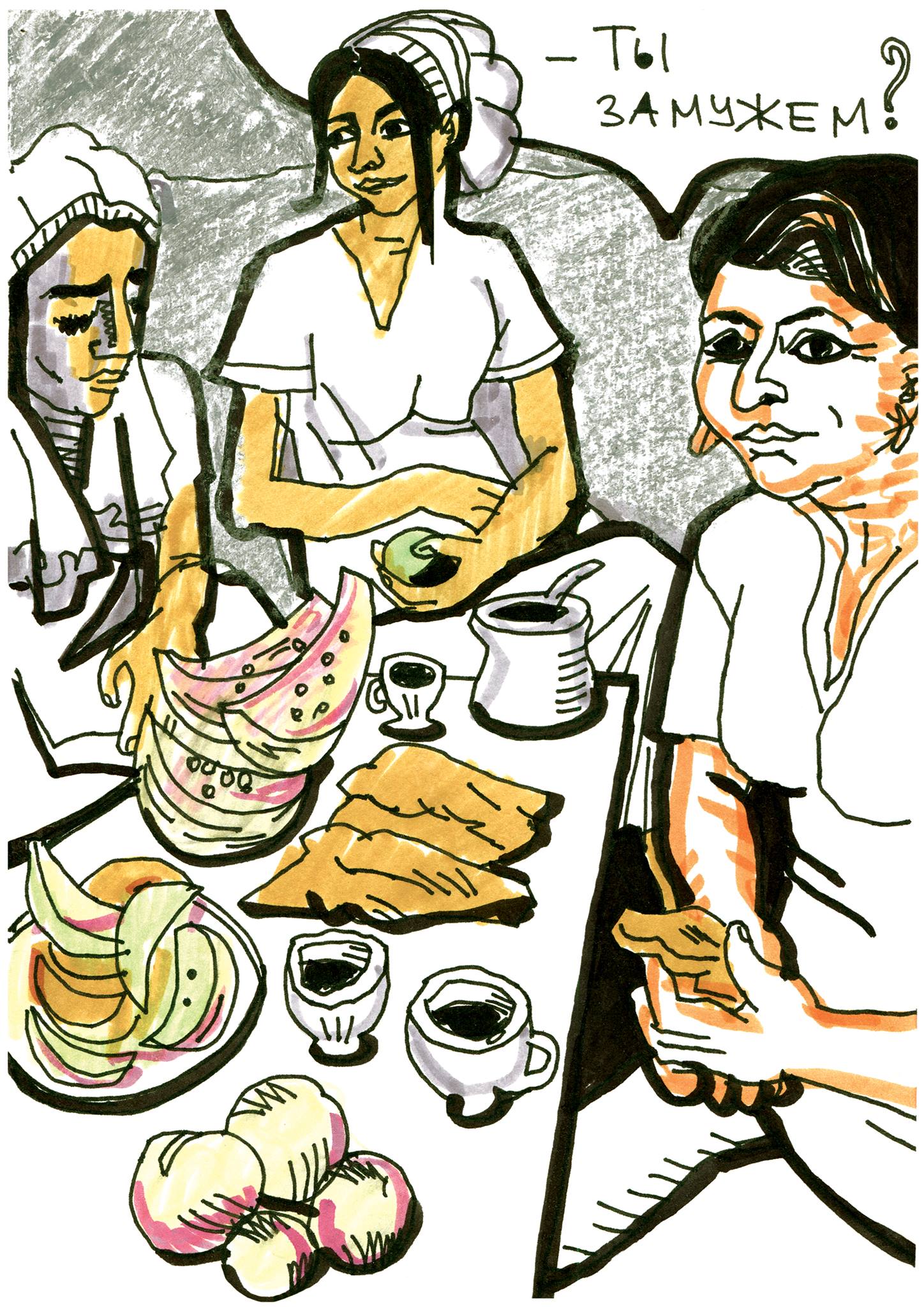
Rossen Djagalov: By way of a final question, I wanted to ask about the perspectives that exist for politically engaged art today. Currently, in Russia, and not only in Russia, there is a certain lull in social movements. Or maybe there are other more pressing problems engaged art is facing, such as the lack of a network of leftist artists, audiences, spaces, forms. What does the future hold for you and other politically engaged artists?
Victoria Lomasko: I feel that right now what’s shaping cultural production more than anything else are not censorship or repression, but economic problems. Truly, many artists find themselves in situations in which they do not have the opportunity to do quality work on social issues. There are no resources. As for perspectives? One option, of course is to focus on working abroad, which is what the “What is to be done” group (Chto delat’?) did. I am afraid that’s an option I am facing myself. In Russia, critics and audiences don’t see my work, don’t react to it, don’t publish or exhibit it. These days even all the free work that I give to different causes, all that I publish in social media doesn’t get much of a reaction. There is a sense of fear, disappointment and exhaustion. In my opinion, our time is similar to the time that followed the events of 1905, when even good artists spent time in depression and produced just time-pieces we don’t remember. By the way, the most interesting artifacts from the left from that period are reportage drawings, because, well, for that, at least, there was enough strength and this medium is also inexpensive.
Rossen Djagalov: So maybe we need more exoticism! 😉 You yourself mentioned in your lecture that there is always a great audience demand for that.
Victoria Lomasko: True, the moneyed Russian audience has always liked huge oil paintings. I think I can easily paint such bright-colored canvases, for example, of young Kirgiz transgenders in the only gay club in Bishkek, but probably it would be even easier to change my profession.
Rossen Djagalov: Let’s not do that: we need your graphic reportage, Vika!
Translation: E. I.


